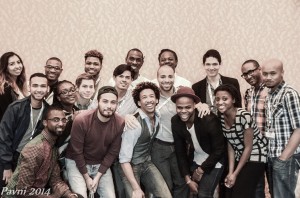Being Social at the U.S Conference on AIDS, #USCA2014
Content From: Yumna Bahgat, New Media Coordinator, AIDS.gov, and Pavni Guharoy, Communications Director, AIDS.gov•Published: October 07, 2014•4 min read
Topics

NMAC Youth Scholar Workshop: Engaging the Millennials
HIV.gov offered a pre-conference workshop entitled “Utilizing Social Media” during the NMAC Youth Scholar orientation on Wednesday, October 1. It was a rare opportunity to hear from over 20 Youth Scholars who are working as community advocates at local HIV organizations, or who are self-made local advocates working to mobilize communities across the nation through their personal networks.
The session closed with a discussion on how they can plan their social media strategy by using the POST (People, Objectives, Strategy, Technology) assessment, a planning tool that is especially useful for implementing communications and social media strategies with limited resources. All of the Scholars are deeply committed to using their voices for HIV advocacy and were appreciative of this in-person brainstorming session.
HIV.gov Social Media Lab: Free, In-person, 20-minute tutorials

Over three days, lab staff offered 20-minute tutorials for conference attendees to learn and share their experiences about using social media to extend their online community outreach and organizational presence. A representative from an organization who had never used social media before asked about how to set up a Twitter account and send out their first tweet. Other attendees asked about how to integrate their existing suite of social media outlets to maximize their follower engagement.
Individuals faced two types of social media challenges. The first was to determine whether social media was the right way to reach their audiences and which tool would be the best fit. The second was how to increase online engagement from communities that are highly stigmatized and may not want to be publicly associated with an HIV-related Facebook page.
Here are some tools representatives from a few organizations learned at the USCA 2014 HIV.gov Social Media Lab:
- Charisse Ahmed, from the Minority AIDS Program-Alachua County Health Department, came to get some advice on how she could get started using new media, how she could manage social media accounts for HIV advocacy, and how she could use social media to promote services that her organization offers. At the lab she learned about different social media management tools that HIV.gov uses (e.g., SproutSocial), and she discovered that, with proper planning, she can schedule her social media posts.
- Shanika Cornelius, of the Ryan White HIV Planning Council, wanted to learn how she could get started using new media. We chatted about how she could log into her Twitter account and send her first tweet by using the conference hashtag #USCA2014Exit Disclaimer to bring more visibility to her account.
- Bessie Lopez, from the Puerto Rico Department of Health, came to the lab to talk about increasing Facebook and Twitter engagement. She learned how she could use the POST (People-Objectives-Strategy-Technology) assessment to develop a social media strategy for her organization’s outreach and how she could plan more effectively, even with limited resources.
- Dorothy Clinton, from Newark Community Health Centers, Inc., was interested in how her organization could link people to testing through new media. We showed her how she could use the HIV.gov Locator widget to promote local testing sites.
- Sara Hamilton, from Funders Concerned About AIDS, wanted to sharpen her new media skills at the lab. We gave her advice on setting goals and monitoring her social media activities by using Twitter analytics. We also looked at the importance of strategic planning for new media, including the importance of creating editorial calendars.